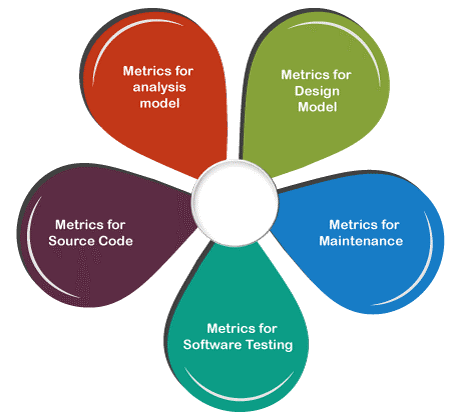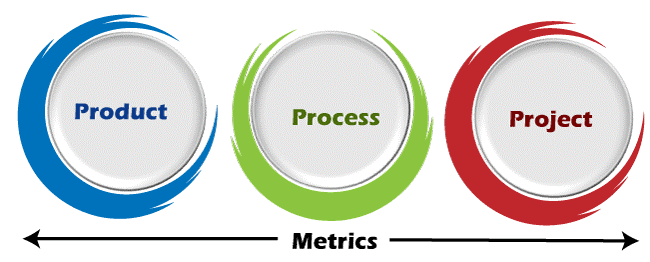Software Metrics
Introduction
Software metrics is the term used in software engineering. Software engineering is the detailed study of the step-by-step making of user-interactive software that fulfills users' needs. Let's discuss two terms a) measure b) metric
Measure: Measure is the quantitative indication of amount, capacity, size, attribute of a component like to take the measure of things/ objects by using devices, units, etc. For example, measurement of height, weight, etc.
Metrics: In general terms, metrics are a synonym of measure, but metrics told the quantitative measure of degree/ percentage of an attribute in a component. For example, 80% reliable, 50% efficient in software.
Definition: “Software metrics is the measurement of software characteristics which are quantifiable and countable.”
Software metrics contain tools used to measure entire software on different parameters.
Why is there a need to measure software?
- It helps to determine the quality of the current product or process.
- It also predictsthe quality of the product/ process.
- It helps to improve the quality of a product/ process.

Few motivations for metrics
- With software metrics, we can estimate the cost and schedule of future projects.
- Improves the quality of software
- Evaluate the productivity impacts of new tools and techniques included in the system.
- Forecast the staff needs
- Reduce the future maintenance cost of the software.
Software metrics are used to check the quality of the product, and there are three types of metrics.

1. Product metrics
Product metrics describe the characteristics of the products. Characteristics of products include their size, complexity, design features, performance, quality level (states product is of high level, low level, or medium level), reliability ( how properly does product/ software works), usability, portability, style metrics, and functionality. Some internal product attributes like design, analysis, code model, and effectiveness of test cases.
2. Process metrics
Process metrics are used to improve the development and maintenance activities of the software. For example:-
- It measures the effort required in the process of developing the product.
- Measure the time to produce the product.
- It states the effect of development tools and techniques used in product making.
- Several defects were found during testing and after using the software after the delivery of the product.
- It tells about the productivity and quality of the process.
- It measures the efficiency and failure rate of the process.
- It measures the time required to fix the number of errors found before and after delivering the product.
- Measure human efforts used for the development of software and actual and estimated and actual cost of the product.
3. Project metrics
Project metrics are connected with the project's completion and characteristics that include project cost, productivity, schedule, number of software developers, their work flow, staffing pattern over the life cycle of software, evaluate teams ability, etc.
Project metrics also include a group of two measures:-
- Direct measures – These measures include attributes like speed, memory, cost, and effort on the product. Process duration, several defects discovered, and the length of source code is also considered.
- Indirect measures – These measures include quality, functionality, maintainability, complexity, reliability of the product and process.
Some other types of metrics are:-
Requirements metrics – As the name defined, these metrics are related to different aspects of requirements, including the size of requirements, traceability, volatility, and Completeness.
Software package metrics – This type of metric is related to various aspects of software packages. It checks the packaging of the software, which include:
- The number of classes and interface include coupling, number of abstract classes in the package.
- Package dependency cycle in which package hierarchy depend on each other.
Software Maintenance Metrics – This type of metrics used to measure the maintenance phase of software that includes:
- Fix responsiveness
- Time of fix response
- Fix backlog
- Backlog management index
Resources metrics: This is used to measure the resources used in building the software.
Personnel metrics: This metric is related to productivity metric, skill matric, and communication metric.
Software metrics– This metric includes paradigm metrics, performance metrics, and replacement metrics.
Hardware metrics – This metric is the combination of availability, performance, and reliability metrics.
Implementation metrics – This type of metrics related to implementation efficiency includes parallel speedup, raw speed, and parallel efficiency.
Customer problem metrics – This metric is related to the percentage of customer satisfaction, neutral customers, customer complaints, and customer requirements. It also measures:
NPS –Net Promoter Score
CES – Customer effort score
CSAT – Customer Satisfaction Score
Software engineering is related to software production, software assessment, measurement, requirement, and application of a wide range of software metrics. It is necessary to develop more accurate metrics (way of measuring software products). Software metrics are measuring tools that define the percent accuracy of the software on various parameters.
Characteristics of software Metrics:

- Due to its quantitative nature, metrics are demonstrated in values.
- The computation of metrics is easy to understand.
- Software metrics apply to the development of software.
- When the software is measured repeatedly, then the value of software metrics should be kept the same and consistent.
- Software metric computation must be economically correct.
- A software metric is independent of any programming language.